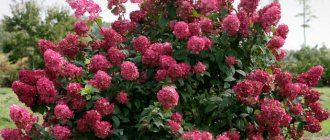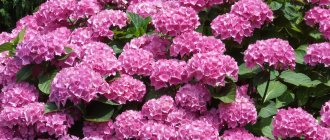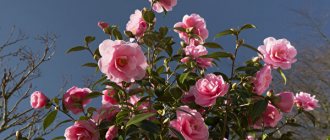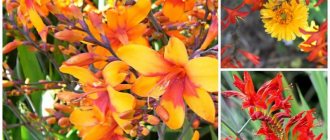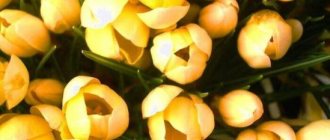Exotic plants of an unusual type, which many gardeners want to see on their plots, are often capricious and too demanding in terms of maintenance conditions to become a worthy decoration for their summer cottage. You can take the word of the seller from the garden center that any bush will delight its owner with abundant flowering for many years, and purchase some expensive plant. But it often happens that it turns out to be too capricious and does not bloom at all. If you want to plant something unusual on your property to surprise your neighbors, but don’t have to worry too much about caring for the plant, you can buy Rogersia conco-chestnut-leaved. This plant, judging by its name, looks like a horse chestnut, but is not a tree, but a shrub.
Rogersia concochestanofolia: description of the plant
Rogersia belongs to the Saxifraga family. It is decorative and is often used for landscaping European parks, but in Russia it is not yet widespread enough. But it is quite possible that it will soon gain popularity due to its unusual and very decorative appearance. During the flowering period of Rogersia concochestnutifolia, the inflorescence of this plant vaguely resembles how a chestnut blooms, but the buds themselves are smaller, white, and collected in a panicle.
Why doesn't Rogersia bloom?
This question often arises among gardeners who are planting Rogers on their site for the first time. But don't panic ahead of time! The first flowering period occurs 3-4 years after planting. In the first two years the plant develops slowly, but then it accelerates in growth.
Reasons why, after the “teenage” period, the flower continues to lag behind:
- excess sunlight, dry air, penetration of winds and drafts;
- insufficient winter insulation leading to freezing;
- lack of watering and fertilizing;
- pest parasitism.
If there is no flowering, it is recommended to transplant the Rogersia to another more suitable place and pay more attention to care and diagnosis of diseases.
Features of perennial
The height of the peduncle can reach 1.5 m. It appears in early July and continues to bloom for about a month. The leaves are feathery, beautiful, rich green. They are located on long petioles growing from the rhizome. In autumn, the leaf blades take on a rich bronze hue, but can change color to purple or crimson Rogers leaves. Planting and care in open ground is not difficult. The main positive quality of this plant is its undemandingness to growing conditions and care. Of course, it has its own characteristics, but it is convenient to grow it in damp and shady areas, where the bush feels good and grows well. This perennial likes soils that are light and nutritious. Loam is best suited.
Types of culture
Rogersia is characterized by decorativeness. The plant includes several species, the descriptions of which are presented in the table.
| Species name | Description | Photo |
| Horse-chestnut-leaved or chestnut-leaved | The length of the shoots of the species reaches 1.8 m. Abundant foliage densely covers the branches. There are bronze stains on its surface, which are clearly visible in the fall, but disappear in the summer. | |
| Cirrus | The plant is classified as low-growing. The height of the bush, together with the towering inflorescences, does not exceed 60 cm. The leaves sparsely adhere to the shoots. There are reddish streaks along the edges. Flowering occurs later than other species. The buds have a cream and pink tint. The pinnate species includes several varieties of Rogersia varieties:
| |
| Centopolist | The crown, together with flowers, rises 1.5 m. The surface of the foliage is glossy with a shade of bronze. Blooming inflorescences have a greenish-cream color | |
| Chocolate Wings or Chocolit Wings | During flowering, the towering inflorescences rise to a height of 120 cm. Each of them produces several flowers of a pale pink hue. The species received its name because of the chocolate color of the leaves during the initial period of growth. Then their color changes to green |
The use of Rogers in landscape design
The plant is associated with Asian countries, wet forests along river valleys and mountain slopes, but at the same time it strongly resembles the familiar horse chestnut. It's all about the dissected leaves, covered with deep veins. Rogersia conco-chestnut-leaved grows on the banks of reservoirs, so it prefers humid conditions. It is advisable to plant it in shady areas protected from cold winds.
Tall plants can become companions for Rogersia in landscape compositions and on alpine hills, then you will get a single surface of foliage of various shapes and textures. A variegated mixture of shrubs and other shade-tolerant perennials looks beautiful. The plant is used for decoration not only in single plantings, but also in group compositions. It goes well with hostas, bergenia, various flowers and ferns.
The height of the Rogersia conco-chestnut-leaved bush can reach 1.5 m. This should be taken into account when creating compositions with other plants. The bush grows about half a meter wide; one leaf in favorable conditions can reach the same size. The plant looks good in Japanese-style stone gardens and can decorate a large alpine hill and rock garden. You can plant Rogers as a single plant in the shade of trees or on a lawn near your home. Then this exotic plant will definitely not go unnoticed by the neighbors.
Myth 3: A tree with decorative bark will change the winter landscape
One trunk, even if very beautifully colored, is unlikely to change the picture of the winter garden. Imagine the coloristic effect of a lone birch tree in a field, then of a three-trunked one and, finally, of an entire birch grove - and you will understand what we are talking about.
How to fix the situation:
If you want your garden to impress guests even in winter, use multi-stemmed forms of ornamental bark plants or plant them using the bouquet planting method.
Three- or four-trunked Maak bird cherry trees, birches, greenbark maples, “Russian eucalyptus” poplars in winter will produce a much greater effect than single-trunked ones.
Ornamental bark shrubs are multi-stemmed by nature, but they should be regularly rejuvenated by planting them on a stump. It is on young shoots that the bark is the brightest. Such shrubs can be completely neutral in the summer and not attract attention to themselves, but when they shed their leaves, they immediately become almost the main accent. Such a change in points of attraction is very favorable, especially in small gardens.
Rogersia: planting and care in open ground
The shrub prefers nutritious soils. When planting in a hole, you need to add a mixture of compost, peat and humus. The soil should be loose, light and rich in minerals. Having chosen a place and prepared a planting hole, you can begin planting Rogers conco-chestnut-leaved. The root system is not buried too deep. The depth should not exceed 5 cm. The plant is covered with soil and immediately mulched. Mulch helps retain moisture and prevents the rhizomes from drying out. The bush develops quickly and in two years will have a decorative appearance. If planting was done correctly, the plant can remain in one place for decades, and this only benefits it.
Planting a plant
In order for Rogers to tirelessly delight you with colorful flowering, and its foliage not to lose its lush shape and emerald hue, the soil for planting must be enriched with humus, peat or compost. The root system is buried into the prepared soil by only 4-7 cm.
Before planting Rogers, be sure to enrich the soil with fertilizers.
2-3 years after planting, Rogers will reach adult size. This fact should definitely be taken into account if you are thinking about creating decorative flower arrangements in landscape design. The right place for planting and soil enriched with nutrients is half the success of growing a beautiful and healthy plant.
Growing Rogersia
When planting is completed and caring for Rogers in the open ground begins as an adult plant, you need to devote time to regularly watering the plant, especially in the summer. The bush will not need any more special care. In autumn, when the growing season is over, the plant is pruned at the root. Growing Rogers conco-chestnut-leaved in winter does not require special attention from the gardener. The bush is quite cold-resistant and does not need additional shelter for the winter. It easily tolerates frosts down to -25 °C. You can mulch the ground around the plant with dry leaves, peat chips or other covering material. But the piece of stem remaining after trimming the shoots must be left free.
ROGERSIA
“Rogersia pinnate “Elegance” PHOTO: www.objava.deti74.ru
PHOTO:
ROGERSIA - so far exotic in our gardens. Rogersia is a very large, up to 1.2 m, perennial herbaceous plant with an abundance of beautiful leaves, dissected like those of a chestnut tree. In mid-summer, the plant develops a large peduncle with a large inflorescence of white flowers.
Over time, the plant grows well, forming a curtain up to 1.5 meters wide. Not all species grow steadily here. You also have to wait quite a long time for flowering.
One of the most difficult tasks of a gardener is creating beautiful flower beds for different areas of the garden. To get acquainted with the author’s ready-made ideas for creating them and photographs of the colors used, we suggest watching this video course!
The most popular types of Rogersia:
ROGERSIA aesculofolia:
Tall, up to 1.2 m in height, perennial herbaceous plant. The leaves are palmately dissected, very reminiscent of the leaves of Horse Chestnut, and when blooming they have a bronze color, which then turns into green. During flowering, a large peduncle with an abundance of white or slightly cream flowers emerges. Fragrant flowers are collected in paniculate peduncles up to 30 cm high. Flowering occurs in mid-summer.
“Rogersia pinnate “Superba” PHOTO: www.original-garden.ru
PHOTO: www.photoshare.ru
The most frost-resistant species in our climate. But it is growing slowly. It has several very decorative varieties: with bronze leaves “Bronze Peacock” , with green leaves - “Die Schоne”, “Werner Müller”, “Spitzentanzerin”, “White Feathers” and others. .
ROGERSIA HENRICI OR HENRICI (Rodgersia aesculifolia var. henrici):
It is a subspecies or variant of Rogersia concochestanifolia. Often used to create varieties and hybrids. The most popular variety of this subspecies is “Cherry Blush” with pink flowers and bronze leaves in dissolution, which, as they grow, turn green in the center and give a crimson border.
“Rogersia Henrici “Cherry Blush” PHOTO: www.podvorje.ru
PHOTO: www.dlya-vas.ru
ROGERSIA podophylla (Rodgersia podophylla):
Tall, up to 1.2 m, plant with leaves similar to Podophyllum leaves (similar to chestnut ones, but the ends of the leaves are pointed and the edges are coarsely toothed). When blooming, it has a red-bronze hue. The flowers in inflorescences are creamy and fragrant. Flowering from mid-summer. There are 2 varieties - “Rotlaub” with red leaves in bloom and “Smaragd” with green leaves even in bloom. Sufficiently winter-hardy.
ROGERSIA pinnata:
It is similar to Horse-chestnut leaf, but has an elongated petiole in the center of the leaf, so the leaves resemble a feather. Flowers collected in lush paniculate inflorescences can be white or pink. Not winter hardy enough. Needs careful shelter. It has very beautiful varieties: with bronze leaves “Chocolate Wings” or “Chocolate Wings” , a very impressive and compact variety with green leaves and soft pink flowers “Superba” , a variety with very tall elegant white inflorescences Elegans flowers .
| “Rogersia concochestanfolia “Bronze Peacock” PHOTO: www.gardencrossings.com |
|
ROGERSIA sambucifolia:
Also a very large plant with leaves strongly reminiscent of Elderberry leaves. The leaves are always green with a bronze tint. The inflorescences are small, cream-colored, fragrant. Unfortunately, it is a less winter-hardy species. Requires careful shelter for the winter. Has the variety "Rothaut" .
“Rogersia elderifolia “Rotlaut”” PHOTO: www.flower-onego PHOTO: Yuri Markovsky
PHOTO: www.daylily.ru
Growing Rogersia - planting and care:
Location:
All Rogerias require semi-shaded or shady places, an abundance of moisture without stagnant groundwater.
The soil:
Fertile, moisture-absorbing loose soil, preferably loam.
Winter hardiness:
Quite tall, except for Elderberry and Pinnate Rogersia. Rogersia overwinters well, but leaving winter quite early, it falls under early and late spring frosts. Its leaves are very sensitive to cold - they freeze even under a double layer of lutrasil - they need to be covered with 4 layers of thick covering material. If you do not constantly live in the garden, you need to take into account that the plant may come out of the ground without you and get frostbitten, i.e. place arcs with shelter above the plant exit site in advance. And although Rogersias recover quite quickly, they may not bloom this year.
"Rogersia chestnutifolia" PHOTO: www.humangarden.ru
PHOTO: www.daylily.ru
Landing:
When planting, the plants are not deeply buried in the ground; the root collar is not lower than 5 cm.
Care:
For the winter, the plant is pruned and mulched with compost or humus. In the spring they will definitely unplant it, but there is no need to rush into it, let the plant come out of hibernation later. In the spring, mineral fertilizing with a predominance of nitrogen is required; in the summer, timely watering, loosening and weeding are required. In extreme heat, they burn strongly even with sufficient watering, so it is advisable to mulch highly with mown grass or tree bark.
|
|
|
Reproduction:
Vegetative - dividing an adult bush in spring or autumn. The rhizome is cut with a sharp knife. The division points are wiped with ash. Seed propagation - Rogersias cross-pollinate well, so to obtain pure-quality material, they are planted away from each other. The seeds are sown immediately. Germination rate is low.
| "Rogersia "Spitzentanserin" PHOTO: www.hswt.de | Rogersia White Feathers PHOTO:www.hswt.de |
Use: Rogersia is good in solitary planting and in natural-style gardens in semi-shaded areas.
MY EXPERIENCE OF GROWING ROGERSIA
“Rogersia podophylfolia variety “Rotlaub” PHOTO: www.chelsad.ru PHOTO: Pryanikova O.V.
PHOTO: www.chelsad.ru
PHOTO: Pryanikova O.V.
Rogersia is one of my favorite plants along with Buzulniki, although this is more related to hopes. I have 5 of them - 2 horse-chestnut leaves, 1 podophylleaf - variety "Rotlaub", 2 pinnate - with simple green leaves and bronze variety "Chocolate Wings". Cirrus has been hibernating for 5 years and is growing extremely slowly. The rest are 3 years old. Horse-chestnut-leaved turned out to be the most adaptable - it grows quite quickly and does not freeze so much during return frosts.
Everything needs to be covered. For the winter, pruning and mulching with humus or compost, and in the spring with a triple or quadruple layer of lutrasil on the arches (a double layer is not enough - Rogersias cannot withstand drops to -8 degrees - then they take a long time to recover). In the spring, you must carefully remove the mulch from the outlet, otherwise it will rot.
My Rogersias have never bloomed like this before.
It is advisable to plant not in complete shade, but so that the morning or evening sun illuminates, but the midday sun does not. They don't grow well in full shade. It is advisable to leave enough space for them; over the years they still grow.
In the very hot summer of 2012, Rogersias got very burnt; they need to be covered with covering material even in the heat.
|
|
|
- < Back
- Forward >
Feeding the bush
The first fertilizing of Rogers conco-chestnut leaf is applied in the spring. For this purpose, nitrogen-containing organic fertilizer is used. The bush responds well to the introduction of nutrients, blooms more profusely and actively grows foliage. In summer it is fed at the root with phosphorus-potassium fertilizer. It is important that complex fertilizers for Rogers contain copper, magnesium, zinc and sulfur. When the plant fades, the inflorescences are removed so as not to spoil the decorative appearance. If desired, it can be transplanted to another place, but, being constantly in one area, it becomes more attractive every year and more and more pleasing to the eyes of its owners.
Rogersia propagation
The easiest way to propagate shrubs is by vegetative method. Most often, dividing the bush is used. This is a simple process that does not cause any problems. When dividing the bush, you immediately get a full-fledged flowering plant. The procedure is carried out in spring or autumn: the rhizome is dug up and divided into several parts. Then the divisions are planted in pre-prepared areas. You can plant Rogers in a group of several plants, but then the distance between them should be at least 15 cm.
Another option is to use parts of the rhizome to propagate the bush, cutting it into pieces about 10 cm in size. It is better to harvest them in late autumn, when the green part of the plant has already died. Pieces of rhizome are placed in distribution boxes 5-7 cm deep and covered with soil or sand. Containers should be stored in a cool place for 4 months. You need to make sure that this place does not freeze. Optimal temperature for propagation by pieces of rhizomes: +5… +10 ºС. A cellar or basement is suitable for this purpose. The soil needs to be moistened periodically to prevent the roots from drying out. In the spring, sprouts will appear, then they can first be transplanted into peat pots, and when the threat of frost has passed and the soil has warmed up, they can be planted in a permanent place.
In summer, Rogersia is propagated using leaf cuttings with a “heel”. This option is more labor-intensive than dividing a bush and takes longer. The stem sections are placed in a container with soil, covered with film and placed in a place protected from direct sun. The cuttings are regularly moistened and ventilated.
Preparing the plant for winter and spring frosts
Caring for Rogers in the fall consists of preparing for winter. Activities begin at the end of September. At this time, dried and damaged shoots are removed from the bush, flower stalks are cut, and the stems are cleared of remaining leaves. If you plan to collect plant seeds, a couple of stems with flowers are left on the bush to form seed plants.
At the end of September, all flower stalks are cut off from Rogers.
During seed formation, the stems do not look very aesthetically pleasing, so the seed plants are left in the background of the Rogers bush.
Rogersia is not susceptible to frost, but it is still recommended to cover it for the winter. Especially in regions with harsh climates, in Siberia and the Urals. In these areas, it is advisable to cover Rogers with spruce branches or a double layer of covering material. Rogersia can overwinter without serious shelter, under a thick layer of mulch, in the Moscow region. But in this region, shelter is only relevant in snowless winters. In late autumn, the surface of the soil around the plant and the root collar are carefully covered with a layer of foliage or straw. When snow falls, it needs to be specially thrown onto the Rogers bush. If there are serious frosts and there is not enough snow, the bush needs to be additionally covered with spruce branches.
You need to be especially attentive to the flower in the spring, when the snow melts and the plant may suffer from frost. At this time, it is recommended to install a frame over the bush and throw a non-woven fabric over it.
Features of seed propagation
Rogersia can be propagated by seeds, but this method is practically not used for a number of reasons:
- The seeds do not germinate well.
- Seedlings grow very slowly.
- If they were pollinated by different varieties, the seedling will not receive the varietal characteristics of the mother plant.
- Varietal characteristics are practically not transmitted, even if the seeds are collected from plants that were pollinated by the same variety.
This option for plant propagation will be useful only to very passionate and patient gardeners, for whom varieties do not matter. For others, dividing the bush is best.
Diseases and pests of Rogers
The plant is very unpretentious and is practically not damaged by pests and diseases if it grows in suitable conditions. The only thing she can get sick with is fungal infections. They arise due to errors in care, when the soil becomes waterlogged or due to excessive watering, after prolonged drying of the root system. It is very important to properly water Rogers throughout the growing season. Then she won't get sick. The substrate in which the bush grows also matters. If the soil is airy, loose and rich in nutrients, the bush grows strong, beautiful and has strong immunity. To prevent fungal diseases, it is advisable to periodically spray the crown with a fungicide solution.

